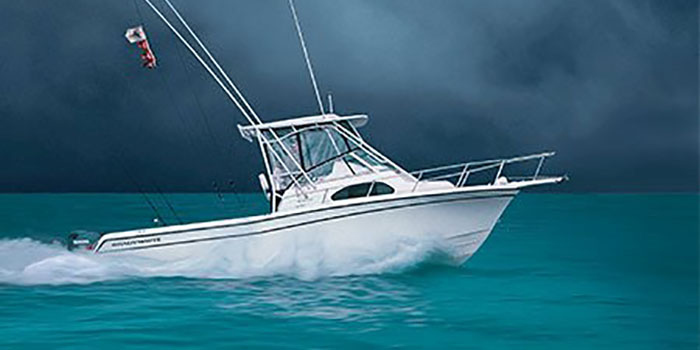All Articles
Boat Handling & Seamanship
Enjoying Your Day, Comfortably
Maintenance
Fishing
Dining Aboard
Trailering
Personal Touches
Performance & Efficiency
Ports of Call & Places to Anchor
All Years
2024
2023
2022
2021
2020
2019
2018
2017
2016
2015
Be Storm Prepared
We all love those beautiful Grady days on the water, but as a responsible Grady owner, you have to deal with the rainy days, too—including the big storms. Here are some common sense tips to be better prepared.
First and foremost: Use common sense and safe practices when ANY storm threatens…and watch your radar.
Summer shower, big front or tropical system: It would seem to go without question, but first and foremost be proactive and use the tools you have at hand to play it safe in avoiding uncomfortable situations. Almost every Grady-White is equipped with equipment that will help you keep one (or two!) steps ahead of the weather. Plus, almost every smart phone comes with radar and weather updates. So even though you are in the safest boat on the water, play it safe with the weather and let caution be your guide!
When the big storms do come, consider these five short guidelines*.
Find a safe place to store your boat when storms threaten.
Hurricanes and even severe thunderstorms pack wind speeds of 30-100 MPH plus. But strong winds are not the only risk to think about when storing your boat in a storm. Storms can create destructive waves when blowing over open water. Then there’s rain. Six to 12 inches (and even more) of rainfall in 24 hours is possible, so be prepared. You should consider looking for another place to keep your boat in a tropical storm if your current location does not have any natural protection from the wind, is exposed to open water in any direction, or could be prone to flooding.
In hurricanes, the biggest danger may come from storm surge–extreme high-water levels that can be much more than the highest high tide. NOAA is a great source of information. Be sure you are confident in the safety measures and professionalism of your marina.
Get the most accurate forecasts for wind, rain, waves, and surge.
Once a storm is approaching, your exact preparations will depend upon the forecast for wind and surge in your area. The National Hurricane Center provides the most complete and current information on potential wind speeds and probable tracks. The National Weather Service’s Hurricane Center.
If you keep your boat in a marina, get a copy of your marina’s storm plan and review it carefully.
You need to understand your obligations, and theirs. Visit the BoatUS Hurricane Center for some examples of good marina plans.
Create your own plan.
Doubling lines on boats left in the water, lengthening scope on moorings, and tying the boat down if it’s on land can make the difference between a boat surviving a storm and not. The BoatUS Hurricane Center details hard-won lessons learned on how to secure your boat including a downloadable preparation worksheet. Use that to think through what you will need to do when a watch is issued.
Check your insurance policy for details
Read the fine print in your insurance policy to make sure you’re covered before and after a storm. Some insurers will pay part of the cost of having a professional move or prepare your boat once a hurricane watch is issued. The best policies cover the cost of salvage without deducting it from the payment to you for damages to the boat. They also provide additional coverage for wreck removal and fuel spills under the policy’s liability provisions.
*adapted from BoatUS materials. Please see BoatUS.com for much more information.
